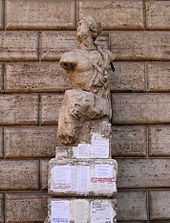Pasquino
| Italian: Pasquin | |
|---|---|
 | |
| Type | Talking statues of Rome |
| Subject |
Menelaus (supporting the body of Patroclus) Supposedly named for Pasquino, a neighboring tailor |
| Location | Piazza Pasquino |
| 41°53′51.80″N 12°28′20.20″E / 41.8977222°N 12.4722778°E | |

Pasquino or Pasquin (Latin: Pasquillus) is the name used by Romans since the Early modern period to describe a battered Hellenistic-style statue dating to the 3rd century BC, which was unearthed in the Parione district of Rome in the 15th century. The statue's fame dates to the early 16th century, when Cardinal Oliviero Carafa draped the marble torso of the statue in a toga and decorated it with Latin epigrams on the occasion of Saint Mark's Day.
The Cardinal's actions led to a custom of criticizing the pope or his government by the writing of satirical poems in broad Roman dialect—called "pasquinades" from the Italian "pasquinate"—and attaching them to the statue "Pasquino".
Thus Pasquino became the first "talking statue" of Rome. He spoke out about the people's dissatisfaction, denounced injustice, and assaulted misgovernment by members of the Church. From this tradition are derived the English-language terms pasquinade and pasquil, which refer to an anonymous lampoon in verse or prose.[1]
The actual subject of the sculpture is Menelaus supporting the body of Patroclus, and the subject, or the composition applied to other figures as in the Sperlonga sculptures, occurs a number of times in classical sculpture, where it is now known as a "Pasquino group". The actual identification of the sculptural subject was made in the eighteenth century by the antiquarian Ennio Quirino Visconti, who identified it as the torso of Menelaus supporting the dying Patroclus; the more famous of two Medici versions of this is in the Loggia dei Lanzi in Florence, Italy. The Pasquino is more recently characterized as a Hellenistic sculpture of the third century BCE, or a Roman copy.[2]
Etymological origins
The origin of the name, "Pasquino", remains obscure. By the mid-sixteenth century it was reported that the name "Pasquino" derived from a nearby tailor who was renowned for his wit and intellect;[3] speculation had it that his legacy was carried on through the statue, in "the honor and everlasting remembrance of the poor tailor".[4]
Tradition of Wit
Before long, other statues appeared on the scene, forming a kind of public salon or academy, the "Congress of the Wits" (Congresso degli Arguti), with Pasquino always the leader, and the sculptures that Romans called Marphurius, Abbot Luigi, Il Facchino, Madama Lucrezia, and Il Babbuino as his outspoken colleagues.[5] The cartelli on which the epigrams were written were quickly passed around, and copies were made, too numerous to suppress.[6] These poems were collected and published annually by the Roman printer Giacomo Mazzocchi as early as 1509, as Carmina apposita Pasquino, and became well known all over Europe. As they became more pointed, the place of publication of Pasquillorum Tomi Duo (1544) was shifted to Basel,[7] less squarely under papal control, disguised on the titlepage as Eleutheropolis, "freedom city".[8]
The lampooning tradition was ancient among Romans. For a first-century versified lampoon, see Domus Aurea.
Pasquinade is sometimes misidentified, appearing among synonyms of parody at WordNet. Compare also the equally unrelated pastiche.
Cultural legacy
In 1589 one of the contributors to the Marprelate Controversy, a pamphlet war between the Established Church of England and its puritan opponents, adopted the pseudonym Pasquill. At the end of his second pamphlet The Return of Pasquill (published in October 1589), Pasquill invites critics of his opponent Martin Marprelate to write out their complaints and post them up on London Stone.
Pasquin is the name of a play by Henry Fielding from 1736. It was a pasquinade in that it was an explicit and personalized attack on Robert Walpole and his supporters. It is one of the plays that triggered the Theatrical Licensing Act of 1737.
The Pasquinade is a small, grassroots magazine of parody and satire started in the mid-1990s by Dallas Shelby, a college journalism student with a bent for satire and a love of pop culture. In 2003, the organization developed its own film production company, Pasquinade Films.
Anthony Pasquin is the pseudonym of John Williams (1761–1818) and his satirical writing of royalties, academicians, and actors.
The Yiddish term Pashkevil is the generic name of the posters put up on the walls of Ultra-Orthodox Jewish enclaves in Israel. These posters define legitimate behavior, such as prohibitions on owning smart phones, as well as often being the mouthpiece for radical anti-Zionist groups, such as the Neturei Karta.[9] Pashkevillim take the place of conventional media in communities where they are shunned.
See also
- Pashkevil
- The Scior Carera in Milan
Notes
- ↑ In verse, the pasquinade finds a classical source in the epigrams of Martial: John W. Spaeth, Jr., "Martial and the Pasquinade" Transactions and Proceedings of the American Philological Association 70 (1939:242-255).
- ↑ Early discussion was summarised in B. Schweitzer and F. Hackenbeil, Das Original der sogennanten Pasquino-Gruppe (Leipzig: Hirtzl) 1936; the modern opinion is from Wolfgang Helbig.
- ↑ http://books.google.com/books?id=Cq5PAAAAMAAJ&pg=PA275&dq=Pasquino+tailor&hl=en&ei=h6xHTM-ROYKC8gbhovmeBQ&sa=X&oi=book_result&ct=result&resnum=2&ved=0CDMQ6AEwAQ#v=onepage&q=Pasquino%20tailor&f=false
- ↑ http://books.google.com/books?id=Cq5PAAAAMAAJ&pg=PA275&dq=Pasquino+tailor&hl=en&ei=h6xHTM-ROYKC8gbhovmeBQ&sa=X&oi=book_result&ct=result&resnum=2&ved=0CDMQ6AEwAQ#v=onepage&q=Pasquino%20tailor&f=false
- ↑ Ponti 1927; Enciclopedia Italiana, s.v. "Pasquino e Pasquinate".
- ↑ Copies in private daybooks have preserved some that were too scurrilous to print.
- ↑ "Two volumes of Pasquinades".
- ↑ Spaeth 1939:245, identifies the editor as the humanist-turned-Protestant Caelius Secundus Curio, an exile and professor of oratory at Basel, whose own Pasquilli Ecstatici had appeared about 1541 and was quickly translated into Italian, French and German.
- ↑ Brother Against Brother: Violence and Extremism in Israeli Politics, E. Sprinzak, 1999, p.95
References
| Wikimedia Commons has media related to Pasquino. |